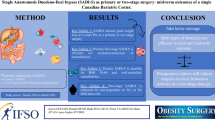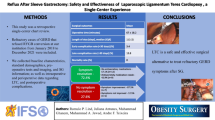Abstract
The management of a newborn with pure oesophageal atresia continues to be challenging. We started treating babies with pure oesophageal atresia by delayed primary anastomosis in 1977. The purpose of this study was to review the long-term outcome in infants with pure oesophageal atresia (EA) treated by delayed primary anastomosis with special emphasis on gastroesophageal reflux (GOR) related morbidity. The medical charts of all patients treated by delayed primary anastomosis between 1977 and 2004 were retrospectively reviewed. All survivors were followed up with completion of a questionnaire and personal/phone interviews. There were 26 patients in total admitted during the 27-year study period with the diagnosis of pure oesophageal atresia. Three died prior to surgery due to associated anomalies; two had almost no distal oesophageal segment and underwent oesophageal replacement surgery. The remaining 21 children were treated with delayed primary anastomosis and made up our study group. There were four deaths (19%) in this group, and all were prior to 1980. The median gestational age was 35.5 weeks and the median birth weight was 2.6 kg; median initial gap was 3.7 cm and median preoperative gap was 1.5 cm; median age at operation was 80 days and the median hospital stay was 5.5 months. The median follow-up period was 13.5 years. Fourteen children (66%) developed symptomatic gastroesophageal reflux and nine of these needed fundoplication (43%). Sixteen children developed strictures at the anastomotic site; ten responded to repeated dilatations while six needed resection and reanastomosis. At the time of this study, 15 out of the 17 survivors (88%) were on normal diet with no respiratory problems and 2 (12%) were dependent on gastrostomy feeds. Our long-term follow-up data shows that the delayed primary anastomosis provides excellent functional results in patients born with pure oesophageal atresia. The high incidence of gastroesophageal reflux and associated morbidity requires early intervention to prevent ongoing feeding problems due to oesophagitis and stricture formation.



Similar content being viewed by others
References
Manning PB (1994) Long-gap esophageal atresia. Semin Thorac Cardiovasc Surg 6:216–220
Lindahl H, Rintala R, Louhimo I (1987) Oesophageal anastomosis without bougienage in isolated atresia—do the segments really grow while waiting? Z Kinderchir 42:221–223
Lafer DJ, Boley SJ (1966) Primary repair in esophageal atresia with elongation of the lower segment. J Pediatr Surg 1:585–587
Rehbein F, Schweder N (1971) Reconstruction of the esophagus without colon transplantation in cases of atresia. J Pediatr Surg 6:746–752
Shafer AD, David TE (1974) Suture fistula as a means of connecting upper and lower segments in esophageal atresia. J Pediatr Surg 9:669–673
Thomasson BH (1972) Congenital esophageal atresia: mercury bag stretching of the upper pouch in a patient without tracheoesophageal fistula. Surgery 71:661–663
Hendren WH, Hale JR (1976) Esophageal atresia treated by electromagnetic bougienage and subsequent repair. J Pediatr Surg 11:713–722
Puri P, Blake N, O’Donnell B, Guiney EJ (1981) Delayed primary anastomosis following spontaneous growth of esophageal segments in esophageal atresia. J Pediatr Surg 16:180–183
Puri P, Khurana S (1998) Delayed primary esophageal anastomosis for pure esophageal atresia. Semin Pediatr Surg 7:126–9
Puri P, Ninan GK, Blake NS, Fitzgerald RJ, Guiney EJ, O’Donnell B (1992) Delayed primary anastomosis for esophageal atresia: 18 months’ to 11 years’ follow-up. J Pediatr Surg 27:1127–1130
Chahine AA, Ricketts RR (2000) Esophageal atresia in infants with very low birth weight. Semin Pediatr Surg 9:73–78
Stone MM, Fonkalsrud EW, Mahour GH, Weitzman JJ, Takiff H (1986) Esophageal replacement with colon interposition in children. Ann Surg 203:346–351
West KW, Vane DW, Grosfeld JL (1986) Esophageal replacement in children: experience with thirty-one cases. Surgery 100:751–757
Ahmed A, Spitz L (1986) The outcome of colonic replacement of the esophagus in children. Prog Pediatr Surg 19:37–54
Spitz L (1992) Gastric transposition for esophageal substitution in children. J Pediatr Surg 27:252–257; discussion 257–259
Boyle EM Jr, Irwin ED, Foker JE (1994) Primary repair of ultra-long-gap esophageal atresia: results without a lengthening procedure. Ann Thorac Surg 57:576–579
Ein SH, Shandling B (1994) Pure esophageal atresia: a 50-year review. J Pediatr Surg 29:1208–1211
Maksoud-Filho JG, Goncalves ME, Tannuri U, Maksoud JG (2002) An exclusively intraabdominal distal esophageal segment prevents primary delayed anastomosis in children with pure esophageal atresia. J Pediatr Surg 37:1521–1525
Foker JE, Linden BC, Boyle EM Jr, Marquardt C (1997) Development of a true primary repair for the full spectrum of esophageal atresia. Ann Surg 226:533–541; discussion 541–533
Guo W, Fonkalsrud EW, Swaniker F, Kodner A (1997) Relationship of esophageal anastomotic tension to the development of gastroesophageal reflux. J Pediatr Surg 32:1337–1340
Davenport M, Hosie GP, Tasker RC, Gordon I, Kiely EM, Spitz L (1996) Long-term effects of gastric transposition in children: a physiological study. J Pediatr Surg 31:588–593
Lindahl H, Rintala R, Sariola H, Louhimo I (1990) Cervical Barrett’s esophagus: a common complication of gastric tube reconstruction. J Pediatr Surg 25:446–448
Varjavandi V, Shi E (2000) Early primary repair of long gap esophageal atresia: the VATER operation. J Pediatr Surg 35:1830–1832
Howell CG, Davis JB Jr, Parrish RA (1987) Primary repair of esophageal atresia: how long a gap? J Pediatr Surg 22:42–43
Lindahl H, Rintala R, Sariola H (1993) Chronic esophagitis and gastric metaplasia are frequent late complications of esophageal atresia. J Pediatr Surg 28:1178–1180
Somppi E, Tammela O, Ruuska T, Rahnasto J, Laitinen J, Turjanmaa V, Jarnberg J (1998) Outcome of patients operated on for esophageal atresia: 30 years’ experience. J Pediatr Surg 33:1341–1346
Cumming WA (1975) Esophageal atresia and tracheoesophageal fistula. Readiol Clin North Am 13:277–95
Desjardins JG, Stephens CA, Moes CAF (1964) Results of surgical treatment of congenital tracheoesophageal fistula, with note on cine-fluorographic findings. Ann Surg 160:141–145
Author information
Authors and Affiliations
Corresponding author
Rights and permissions
About this article
Cite this article
Sri Paran, T., Decaluwe, D., Corbally, M. et al. Long-term results of delayed primary anastomosis for pure oesophageal atresia: a 27-year follow up. Pediatr Surg Int 23, 647–651 (2007). https://doi.org/10.1007/s00383-007-1925-7
Accepted:
Published:
Issue Date:
DOI: https://doi.org/10.1007/s00383-007-1925-7




